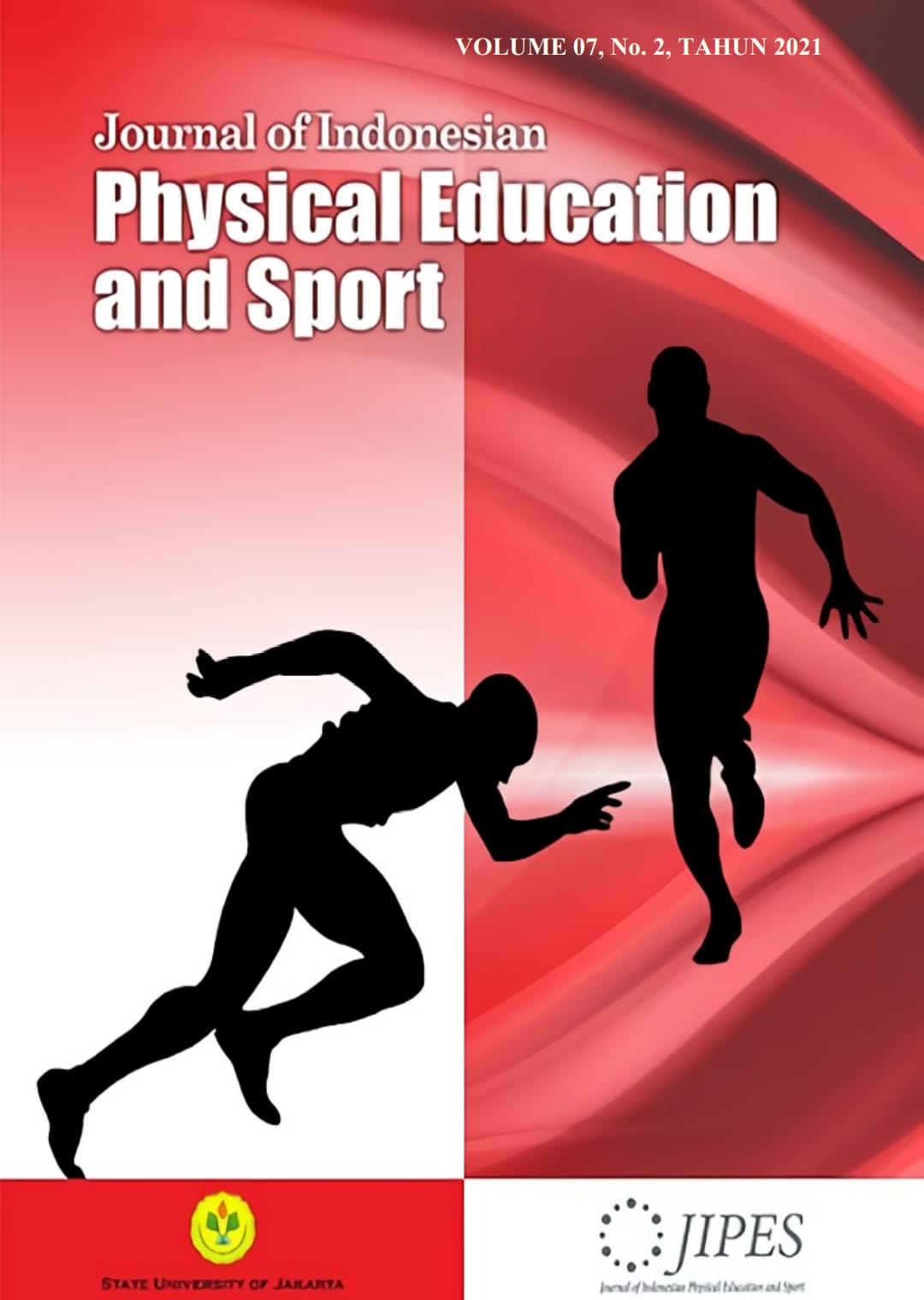OBME For Learning Model Development Basic Students Locomotor Movement
Keywords:
Learning, Outbound Basic Motion Education (OBME), LocomotorAbstract
The purpose of this study was to produce a learning model for Outbound Basic Motion Education (OBME) for basic locomotor movements of elementary school children. The study was conducted to obtain information about the application of the Outbound Basic Motion Education (OBME) learning model. This study uses the Research & Development (R&D) development research method from Borg and Gall. Small group test of 20 students at Negeri 24 Kramat Jati Elementary School, East Jakarta with 45 model items. In a large group trial of 60 students with 31 item models. The effectiveness test of 30 students used the locomotor test with the one group pretest-posttest design, the pre-test data was obtained for 42.7333 and the post-test 72.6333 so that there is a difference with a difference of 29.9, meaning that there is a significant difference and the value of the effectiveness test The post-test is higher than the pre-test score, so based on this it can be concluded that the application of the Outbound Basic Motion Education (OBME) learning model developed by this writer is effective in improving basic locomotor movement skills of elementary school children. Based on the results obtained, it can be concluded that: (1) With this Outbound Basic Motion Education (OBME) learning model students can learn more effectively and efficiently, (2) with this Outbound Basic Motion Education (OBME) learning model, an increase is obtained. It is shown in the pre-test and post-test results that there is a significant difference.
References
Arends, R. I. (2013). Belajar Untuk Mengajar, Learning to Teach. Salemba Humanika.
Beaty, J. (2013). Observasi Perkembangan Anak Usia Dini. Kencana.
Firdaus, M. A., & Nurrochmah, S. (2021). Survei Keterampilan Gerak Dasar Lokomotor, Nonlokomotor, dan Manipulatif Siswa Putri Kelas VII. Sport Science and Health, 3(5), 235–253. https://doi.org/10.17977/um062v3i52021p235-253
Firmansyah, H. (2011). Pengaruh Gaya Mengajar dan Umpan Balik Terhadap Keterampilan Gerak Dasar Senam. Metodik Didaktik, 5(1). http://jurnal.upi.edu/md/view/320/pengaruh-gaya-mengajar-dan-umpan-balik-terhadap-keterampilan-gerak-dasar-senam.html
Hakim, A., & Kumala, F. (2016). Pengembangan Karakter Melalui Kegiatan Outbound. Jurnal Moral Kemasyarakatan, 1(2), 173–182.
Hamzah, H., Mu’arifin, M., Heynoek, F. P., Kurniawan, R., & Kurniawan, A. W. (2020). Pengembangan Perangkat Pembelajaran Model Discovery Learning Materi Gerak Lokomotor Kelas Rendah Sekolah Dasar. Sport Sciences for Health, 2(8), 384–394. http://journal2.um.ac.id/index.php/jfik/article/view/11629
Haris, F. (2018). Pengaruh Gaya Mengajar dan Umpan Balik Terhadap Keterampilan Gerak Dasar Senam.pdf. In Jurnal Sain Olahraga dan Pendidikan Jasmani (pp. 58–64). http://doi.org/10.24036/jss.v%25vi%25i.40
Hidayat, A. (2017). Peningkatan Aktivitas Gerak Lokomotor, Nonlokomotor Dan Manipulatif Menggunakan Model Permainan Pada Siswa Sekolah Dasar. Jurnal Pendidikan Jasmani Dan Olahraga, 2(2), 21. https://doi.org/10.17509/jpjo.v2i2.8175
Mahendra, A. (2007). Modul Teori Belajar Mengajar Motorik. FPOK UPI.
Muhammad Virga Gustifajar, Wasis D. Dwiyogo, dan F. P. H. (2018). Development of Outbound Activities to Embed The Values of Character Education Through Interactive Multimedia. ACTIVE: Journal of Physical Education, Sport, Health and Recreation, 7(1), 33–38. https://doi.org/10.15294/active.v7i1.21414
Muslihin, H. Y. (2020). Bagaimana Mengajarkan Gerak Lokomotor Pada Anak Usia Dini? Jurnal Paud Agapedia, 2(1), 76–88. https://doi.org/10.17509/jpa.v2i1.24390
Nanda. (2015). Diagnosis Keperawatan: Definisi & Klasifikasi (S. K. Heather Herdman (ed.); 10th ed.). EGC.
Pertiwi, R. M., Nurhasan, N., & Syam, T. A. R. (2018). Pengembangan Model Pembelajaran Sirkuit Untuk Membantu Pola Gerak Lokomotor, Non Lokomotor, dan Manipulatif Anak Down Syndrome. Jendela Olahraga, 3(2), 26–36. https://doi.org/10.26877/jo.v3i2.2452
Pristianto, A., Wijianto, & Farid, R. (2018). Terapi Latihan Dasar. Muhammadiyah University Press. https://www.google.co.id/books/edition/Terapi_Latihan_Dasar/dc95DwAAQBAJ?hl=id&gbpv=1&dq=gerak+dasar&printsec=frontcover
Purnomo, E. (2011). Dasar-Dasar Gerak Atletik. Alfamedia. Alfamedia.
Rocmah, L. I. (2012). Model Pembelajaran Outbound Untuk Anak Usia Dini. PEDAGOGIA: Jurnal Pendidikan, 1(2), 173. https://doi.org/10.21070/pedagogia.v1i2.40
Sidik, D. Z. (2010). Pembinaan Kondisi Fisik. FPOK UPI.
Sulistiawati, R. (2017). Mengembangkan Kemampuan Motorik Kasar Anak Melalui Gerak Lokomotor di Taman Kanak-Kanak Widya Bhakti Tanjung Senang Bandar Lampung (Vol. 87, Issue 1,2). UIN Raden Intan Lampung. http://repository.radenintan.ac.id/686/
Trianto. (2009). Mendesain Model Pembelajaran Inovatif Progresif. Kencana.
Wahjoedi, Adi, I. P. P., & Damiati. (2017). Model Pengembangan Pendidikan Karakter Pada Anak Usia Dini Berbasis Outbound di Kota Singaraja. Seminar Nasional Riset Inovatif, 5, 931–940. https://eproceeding.undiksha.ac.id/index.php/senari/article/view/1068/793
Walton, E. R., & Putranto, D. (2020). Pengembangan Aktifitas Gerak Lokomotor Berbasis Media Audio Visual Pada Siswa Sekolah Dasar Kelas Rendah Se Kecamatan Gabek Pangkalpinang. Jurnal Pendidikan Glasser, 4(2), 88–96. https://doi.org/10.32529/glasser.v4i2.695
Wati, G. M. (2012). Outbound Management Training Untuk Meningkatkan Kemampuan Penyesuaian Diri Anak Tunagrahita. Educational Psychology Journal, 1(1), 68–74.
Webiantoro, E., Wiradihardja, S., & Nuraini, S. (2020). Permainan., Model Pembelajaran Lokomotor Usia 6-7 Tahun Berbasis. Jurnal Ilmu Keolahragaan, 19(1), 20–27.










 </a > a
</a > a 